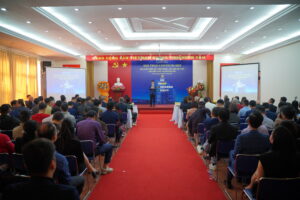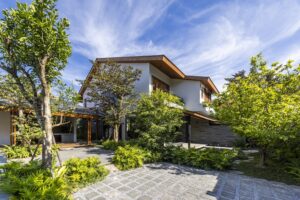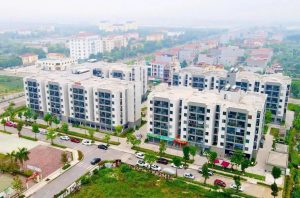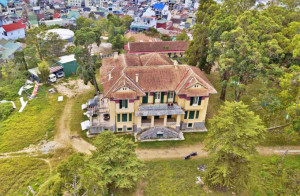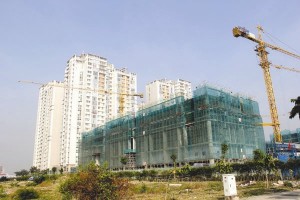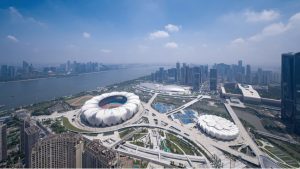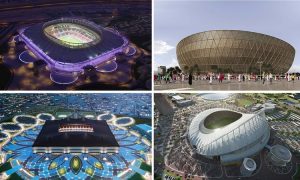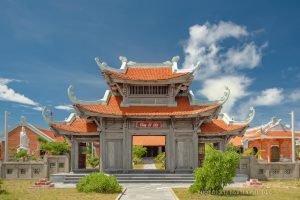Công bố quốc tế trong lĩnh vực kiến trúc, xây dựng (Tuần 3 tháng 9-2021)
Trong số này chúng tôi xin giới thiệu tới quý độc giả những nội dung chính của các công bố quốc tế đăng tải trên ScienceDirect và Springer Nature do Cục Thông tin khoa học và công nghệ quốc gia (NASATI) mua quyền truy cập như sau:
Quy hoạch đô thị:
– Các mô hình không gian-thời gian của đại dịch COVID-19 và các yếu tố ảnh hưởng dựa trên địa điểm ở quy mô vùng lân cận ở Tehran
– Biến đổi khí hậu ảnh hưởng đến thiết kế cơ sở hạ tầng thoát nước mưa ở Tucson Arizona
– Thiết kế đường xanh đô thị có ảnh hưởng đến việc tiếp xúc với ô nhiễm không khí không? Một nghiên cứu điển hình về Seoul, Hàn Quốc
– Hướng tới các thành phố thông minh xanh hơn và dự báo giao thông đường bộ sử dụng dữ liệu ô nhiễm không khí
– Phân tích năng lượng đô thị theo ngữ cảnh (CUE-A): Một khuôn khổ để mô hình hóa các mối quan hệ giữa việc sử dụng năng lượng xây dựng và sự gần gũi về không gian của các hệ thống đô thị
– Các đặc điểm về không gian, cơ sở hạ tầng và tiêu dùng cơ bản về sự biến đổi không gian trong tiêu thụ năng lượng và nước dân dụng ở Amsterdam
– Điều tra các mối quan hệ không cố định về mặt không gian giữa hình thái không gian đô thị và nhiệt độ bề mặt đất: Một nghiên cứu điển hình ở Vũ Hán, Trung Quốc
– Định hình lại khái niệm phát triển theo định hướng phương tiện công cộng để đối phó với tình trạng không gian công cộng quá nóng gần các nút trung chuyển của Tokyo
– Phát hiện mô hình đa trung tâm đô thị thực sự của các thành phố Trung Quốc theo các chiều hình thái: Phân tích đa cấp dựa trên dữ liệu lớn về không gian địa lý
Khoa học và công nghệ trong lĩnh vực kiến trúc, xây dựng:
– Nghiên cứu số lượng ảnh hưởng của quá trình tự phục hồi vết nứt ngang đến tốc độ ăn mòn của thanh thép trong bê tông
– Đo lường không xâm phạm các thành phần tải làm mát của tòa nhà thông qua phân tích thành phần hình thái
– Tính chất cơ học và độ bền của bê tông cốt liệu nylon nén được gia cố bằng sợi Forta-Ferro: Thực nghiệm và tối ưu hóa
– Một mô hình đơn giản để ước tính chiều rộng vết nứt chéo tối đa của các dầm bị hư hỏng trước được tăng cường lực cắt với dải CFRP
– Đánh giá hiệu suất của nẹp tự định tâm dựa trên lò xo đĩa để giảm thiểu nguy cơ địa chấn
– Sự vênh do uốn-xoắn của vòm tròn bằng thép có thể biến dạng chịu cắt khi chịu tải trọng tập trung ở môi trường nhiệt
– Nghiên cứu thực nghiệm và số liệu về tính năng kháng chấn của khung không gian bê tông cốt thép có cột tiết diện không đều
– Phân tích xây dựng theo giai đoạn của các tòa nhà bê tông cốt thép với các hệ thống chịu tải trọng bên khác nhau
– Nghiên cứu thực nghiệm về đầu nối chịu cắt đinh tán nhóm bằng thép đúc sẵn – Cầu liên hợp UHPC
Vật liệu xây dựng:
– Ảnh hưởng của phụ gia hữu cơ đến tính chất tươi và cơ học của vữa trát đất
– Tái chế và cố định cặn khai thác kẽm trong sản xuất gạch đất sét nung
– Sử dụng bền vững các loại nước thải khác nhau trong xây dựng bê tông: Đánh giá
– Các kỹ thuật mới để tiết kiệm năng lượng của các tòa nhà bền vững bằng cách sử dụng vật liệu thay đổi pha
– Khả năng thấm clorua và khả năng liên kết clorua của bê tông biến tính nano
– Tấm trần thạch cao bằng sợi len và sợi xơ dừa tăng cường độ ổn định và khả năng cách âm, cách nhiệt
– Ảnh hưởng của bột alumin thải đến khả năng chịu lực của bê tông tự lèn dưới nhiệt độ cao
– Khả năng cắt đột lỗ của các kết nối cột bê tông cốt liệu tái chế
– Ảnh hưởng của các ống nano cacbon đa thành đã được chức năng hóa đến các tính chất cơ học và độ bền của vữa xi măng
– Phương pháp phân tích đối với hoạt động của màng trong các tấm hình vuông bê tông cốt thép hạn chế về phía dưới các tải trọng phân bố đồng đều
Xin trân trọng giới thiệu!
QUY HOẠCH ĐÔ THỊ
- Spatio-temporal patterns of the COVID-19 pandemic, and place-based influential factors at the neighborhood scale in Tehran
Sustainable Cities and Society, Volume 72, September 2021, 103034
Abstract
Since its emergence in late 2019, the COVID-19 pandemic has attracted the attention of researchers in various fields, including urban planning and design. However, the spreading patterns of the disease in cities are still not clear. Historically, preventing and controlling pandemics in cities has always been challenging due to various factors such as higher population density, higher mobility of people, and higher contact frequency. To shed more light on the spread patterns of the pandemic, in this study we analyze 43,000 confirmed COVID-19 cases at the neighborhood level in Tehran, the capital of Iran. To examine spatio-temporal patterns and place-based factors contributing to the spread of the pandemic, we used exploratory spatial data analysis and spatial regression. We developed a geo-referenced database composed of 12 quantitative place-based variables related to physical attributes, land use and public transportation facilities, and demographic status. We also used the geographically weighted regression model for the local examination of spatial non-stationarity. According to the results, population density (R2 = 0.88) and distribution of neighborhood centers (R2 = 0.59), drugstores (R2 = 0.64), and chain stores (R2 = 0.59) are the main factors contributing to the spread of the disease. Additionally, density of public transportation facilities showed a varying degree of contribution. Overall, our findings suggest that demographic composition and major neighborhood-level physical attributes are important factors explaining high rates of infection and mortality. Results contribute to gaining a better understanding of the role of place-based attributes that may contribute to the spread of the pandemic and can inform actions aimed at achieving Sustainable Development Goals, particularly Goals 3 and 11.
- Climate changes impact on stormwater infrastructure design in Tucson Arizona
Sustainable Cities and Society, Volume 72, September 2021, 103014
Abstract
The stationary-based Intensity-Duration-Frequency (IDF) curves for rainfall provided by the National Oceanic and Atmospheric Administration Atlas 14 (NA14) are the primary data source of stormwater infrastructure design in the United States. Studies have repeatedly signified the non-stationary quality of climatic cycles, which has altered rainfall patterns and increased both frequency and intensity of extreme events, creating a challenge for engineers to adjust design practices under climate change. IDF curves are gradually being updated with climate models to accommodate the adjustment. Yet, many sources of uncertainty, including model selection, can significantly change the final stormwater design. This study updates the IDF curves for the City of Tucson, Arizona, U.S., comparing projections of eight Coupled Model Intercomparison Project Phase 6 (CMIP6) General Circulation Models (GCMs) for the future period (2020–2051). Observed local rainfall data was obtained for the historical period (1970–2001) and used for bias-correcting the models. Utilizing the regional frequency analysis method of NA14, IDF curves were updated for Tucson using the Partial Distribution Series (PDS) as the extreme series. The model selection in this study was based on annual maximum series (AMS) and PDS; however, due to uncertainty associated with GCMs, results for all models were presented, making it clear the extent to which the model selection can affect the design and cost of stormwater systems. Initial results attested to an increase in projected extreme events, their underestimation using stationary assumption, and the need to update IDF curves for Tucson. Moreover, the projected extreme values are greatly affected by model selection and scenarios. An illustrative stormwater culvert design showed that the differences in models’ output could double the design size and considerably increase the cost. The model selection approach utilized in this study can facilitate engineers’ and public works decision-making process by filtering out a wide range of projections to fewer preferred options based on GCMs’ historical performance over the extreme series as the primary input of IDF curves.
- Does urban greenway design affect air pollution exposure? A case study of Seoul, South Korea
Sustainable Cities and Society, Volume 72, September 2021, 103038
Abstract
This study investigates whether different urban greenway designs can influence personal exposure to air pollutants in highly urbanized environments in Seoul, Korea. Mobile and in-situ measurements of ultrafine particles (UFP) and black carbon (BC) concentrations were conducted on three different types of urban greenway designs: 1) an at-grade greenway next to traffic; 2) an elevated greenway above (10−14 m) traffic; and 3) a sunken greenway below (2.5−3 m) traffic. Results from the mobile measurements showed that the UFP and BC concentrations were up to 30 % lower on all types of greenway than on sidewalks. This result was further confirmed by the in-situ measurement, which showed 47 % lower UFP concentrations in the sunken greenway and 80 % lower BC concentrations in the elevated greenway compared to the sidewalk. Pollutant concentrations also varied according to microenvironmental factors, such as land uses, height of surrounding buildings, nearby traffic, and vegetation. Our findings highlight the importance of considering air pollution exposure when designing urban greenways in highly urbanized environments. In particular, greenway designs that promote vertical separation from traffic sources might be crucial in mitigating air pollution exposure. The results of this study are based on data gathered over a six-day field measurement, and further studies over a longer time period are warranted to confirm our findings.
- BIM-enabled multi-level assessment of age-friendliness of urban housing based on multiscale spatial framework: enlightenments of housing support for “aging-in-place”
Sustainable Cities and Society, Volume 72, September 2021, 103039
Abstract
The worldwide population of the elderly has increased rapidly. Housing issue is regarded as the main barrier to implementing “aging-in-place”, which is a recommended strategy to encourage the elderly to age in their residences. Although many studies have contributed to age-friendly cities and communities, few studies have focused on measuring housing age-friendliness with consideration of urban spatial scales. This study proposes a multiscale spatial framework of housing and develops a multi-level assessment of housing age-friendliness based on literature review and fuzzy-analytic hierarchy process (AHP). The multi-level assessment of age-friendliness takes advantage of building information modeling (BIM) to simplify the computation process of the housing age-friendliness index (HAFI). The feasibility of BIM-enabled multi-level assessment is proved by comparative analysis of two housing examples. Results of HAFI and sub-HAFIs indicate housing may perform variously with spatial levels. This study contributes to developing the age-friendly performance assessment for housing by considering various significances of housing characteristics in multiple spatial levels. The BIM-enabled multi-level assessment is an effective tool to help the elderly choose more appropriate housing, assist the government in allocating suitable public housing for aged applicants, and provide property developers and local governments with additional guidelines for housing design and urban renewal.
- Towards greener smart cities and road traffic forecasting using air pollution data
Sustainable Cities and Society, Volume 72, September 2021, 103062
Abstract
Road traffic flow forecasting is among the most important use case associated with smart cities. Traffic forecasting allows drivers to select the fastest route towards their target destinations. A prerequisite for traffic flow management is accurate traffic forecasting. In this study, we introduce a framework for traffic forecasting that uses data on air pollution. The reason to select that data is air pollution rates are often associated with traffic congestion, and there is intensive research that exists to forecast air pollution by road traffic. To the best of our knowledge, any effort to enhance road traffic prediction through air quality and ensemble regression model techniques is not yet been proposed. In this research, our contribution is twofold. Firstly, we have performed a comparative analysis of 7 different regression models to find out which model gives better accuracy. Secondly, we propose a framework using regression models in which the first regression model’s result is boosted using boosting ensemble method and is passed to the next regression model which shows that the proposed framework gives more satisfying results than the above 7 regression models. The experimental findings show the effectiveness of the proposed framework which decreases the error rate by 2.47 %.
- Context-aware Urban Energy Analytics (CUE-A): A framework to model relationships between building energy use and spatial proximity of urban systems
Sustainable Cities and Society, Volume 72, September 2021, 102978
Abstract
Cities account for over 75% of primary energy use in the world, with buildings making up a significant share of this energy use. Previous simulation-based research has established that building energy use can be greatly impacted by surrounding urban systems such as other buildings, vegetation, and roads. Understanding these relationships is thus critical to enhancing the efficiency of energy-intensive urban environments. Taking advantage of the recent profusion of urban data, this paper proposes a novel Context-aware Urban Energy Analytics (CUE-A) framework to empirically extract and quantify the relationships between building energy use and the spatial proximity of multiple surrounding urban systems. We apply the CUE-A framework to a case study of 477 buildings in a mid-size U.S. city to demonstrate its merits and the statistical significance of explored relationships. Results show that spatial proximity of other buildings, trees, and roads is associated with varied and significant changes in both the central tendency and variability of building energy use, indicating that empirical frameworks, which are a growing field of work, can serve as useful complements to existing simulation models. Further, our paper demonstrates that energy-aware urban planning and design has the potential to unlock energy efficiency and low-carbon pathways for cities around the world.
- Spatial, infrastructural and consumer characteristics underlying spatial variability in residential energy and water consumption in Amsterdam
Sustainable Cities and Society, Volume 72, September 2021, 102977
Abstract
To design effective strategies for sustainable urban resource management, it is essential to understand which urban characteristics underlie consumption patterns. We used multiple linear regression analyses to examine sixteen factors on their explanatory power for spatial variation in residential electricity, gas and water consumption in Amsterdam. Four models per resource were used, based on distinct spatial units aggregating high-resolution data: neighbourhoods, districts, 100 m squares and 500 m squares. We found twelve explanatory variables for spatial variability in consumption in total and nine or ten per resource. The number and relative importance of explanatory variables varies with the spatial units used. Overall, neighbourhood models explain variance in consumption data best (adjusted R² = 0.88, 0.86, 0.74). Income level and building type stand out for having high relative importance (top 4) in all four models for two of the three resources; migration history shows an important correlation with water consumption, which was not described hitherto. We conclude that explanatory variables for resource consumption are sensitive to size and shape of spatial units used. We recommend to use future high resolution studies for different resources of interest to determine which spatial and temporal resolutions of analysis can support urban planners and designers in formulating context-specific interventions.
- Investigating the spatiotemporal non-stationary relationships between urban spatial form and land surface temperature: A case study of Wuhan, China
Sustainable Cities and Society, Volume 72, September 2021, 103070
Abstract
This article aims to examine the pathways of urban spatial forms in mitigating urban heat island (UHI) intensity across urban areas in different seasons. By investigating the case of Wuhan, we quantified urban spatial form (USF) factors concerning land use, land cover, and building-group morphology and the land surface temperatures (LST) in summer, autumn and winter of 2,357 block units. The seasonal relationships between USF and LST are explored at the large scale of the whole study area and different zones of block units categorized by floor area ratio. The results suggest that relationships between USF and LST vary spatially and temporally. First, although most urban spatial form factors show significant correlations on LST at the global scale, the correlations vary significantly among low, medium, and high floor-area-ratio zones. Second, USFs largely contribute to the variance of LST in summer and autumn compared with winter. Third, building morphology exerts more impact on LST in relatively highly intensive built-up zones, while land use and land cover factors have more impact in low-intensity areas. Lastly, UHI can be precisely mitigated by optimizing USFs considering the varied relationships between USFs and LST. This study theoretically deepens the understanding of the variation of the relationships between built-up urban areas and UHI at the scale of the basic planning regulation units, which is conducive to formulating down-to-earth regulation measures to cool cities and communities.
- Reshaping the concept of transit-oriented development in response to public space overheating near the transit nodes of Tokyo
CitiesVolume 116, September 2021, 103240
Abstract
In Tokyo, the overheating of public spaces in summer is a challenging issue that needs to be resolved for the vibrant social life in this city to be sustained. The urbanisation of Tokyo is based on transit-oriented developments (TODs); this study focused on understanding the correlation between the urban heat island (UHI) effect and public spaces within TODs and on providing solutions for mitigating the overheating of such spaces. The onsite microclimatic data of 30 public spaces near transit nodes were compared with average daily weather forecast data to identify the overheating levels. The spatial structures of the selected areas were then analysed to identify possible planning issues that led to the overheating. Public spaces with high-overheating levels tended to have a lack of vegetation and to be small, dry, and blocked from the wind flow. Public spaces that were not overheated tended to be wide, green, and shaded. These spaces had a microclimate similar to the daily weather forecast. These findings were used to develop new planning guidelines for improving TODs, developing overheating mitigation strategies for public spaces, and identifying future directions for sustainable improvement of the urban structure.
- Towards a hybrid model for the management of smart city initiatives
Cities, Volume 116, September 2021, 103278
Abstract
This paper explores how urban planners can use a hybrid organization to manage smart city initiatives. We use an inductive qualitative case study approach based on connecting emergent concepts through Gioia’s method to answer the following research question: “How can hybrid organizations manage a complex network of actors in smart city initiatives?”. The study highlights that in managing smart city initiatives, hybrid organizations benefit from actor-network theory. Additionally, for a more in-depth view, the study investigates the framework provided by Chourabi to test the hybridity theory. Overall, the results suggest that hybridity is feasible and increases the output directed towards citizens. The paper contributes to the existing literature on both hybrid organizations and smart cities. We conclude that despite the conventional distinction between public and private entities, managing smart city initiatives that include complex factors such as new technologies may require the adoption of hybrid management solutions by urban planners, especially when multidisciplinary and complex skills are required. Thus, smart city solutions are most effective when combined with hybrid management models. This research has utility for urban planners, policymakers, and researchers. It aims to support practical management solutions (analysed through a theoretical lens) to foster smart city initiatives.
- Can one brand fit all? Segmenting city residents for place branding
Cities, Volume 116, September 2021, 103287
Abstract
Many city branding campaigns fail because they ignore input at the planning stage from local residents, who are among the most crucial stakeholders. Moreover, many campaigns that do consider residents fail to address the varying preferences, attitudes or needs of different groups. To help prevent these mistakes, the current study identifies different segments of residents based on their degree of involvement in and attachment to the city. Four segments of residents who differ in their perceptions of city image, loyalty and socio-economic status are identified. The findings illustrate the heterogeneous nature of city residents and suggest practical implications for city marketers and municipalities.
- Critical factors influencing the comfort evaluation for recreational walking in urban street environments
Cities, Volume 116, September 2021, 103286
Abstract
Walking has been actively advocated as a simple and effective means to boost individuals’ physical activity levels. Comfort, as one of walking needs, is also the major objectives for many street design guidelines and walking audit tools. However, a few studies only identified the major environmental factors in a piecemeal manner without providing an integrated view on pedestrian comfort for recreational walking. This study aimed to identify the major micro- and built environmental factors and reveal their relative importance. 420 questionnaire responses with concurrently monitored micro-environmental conditions were analyzed to formulate a path model that portrayed the interrelationships between pedestrian comfort, and perceptual and objectively measured street built and micro-environmental characteristics. Our results showed that pedestrian comfort could be directly evaluated by pedestrians’ satisfaction of built environment, thermal sensation, perceived air quality and loudness. The influence of satisfaction of built environment alone was found to be comparable to the aggregate influences of thermal sensation, perceived air quality and loudness. Thermal sensation, perceived air quality and loudness were found to mediate the associations between objectively measured parameters and individual recreational walking comfort respectively. The findings provide valuable insights for urban planners to improve the comfort level of recreational walking in streets.
- Disentangling the impacts of the built environment and residential self-selection on travel behavior: An empirical study in the context of diversified housing types
Cities, Volume 116, September 2021, 103285
Abstract
Due to spatial heterogeneity worldwide, results from studies examining the effect of residential self-selection on travel behavior vary substantially. As a result of housing reform, the unique housing allocation system in China is a prime example of a context where the self-selection effect may conflict with international knowledge. Using a sample of 3836 residents, whom are living in Transit-Oriented Development (TOD) and non-TOD neighborhoods in Shanghai, this study untangles the effects that the built environment and residential self-selection have on travel behavior, in the context of diversified housing types in urban China. Specifically, this paper employs propensity score matching (PSM) to quantitate the relative importance of the built environment itself, verses residential self-selection, in influencing travel behavior for each of the housing types. The results show that the residential self-selection effect in the four types of housing (work-unit, commodity, public, and replacement) accounts for 15.2%, 30.7%, 18.5%, and 5.9% of the total impact on vehicle kilometers traveled (VKT), respectively. These findings expand the international database of point estimates in the relative contribution of self-selection toward the impact on travel behavior across global contexts, providing a comprehensive framework for similar studies on self-selection in other parts of the world.
- Detecting the true urban polycentric pattern of Chinese cities in morphological dimensions: A multiscale analysis based on geospatial big data
Cities, Volume 116, September 2021, 103298
Abstract
With current decentralization trends and polycentric planning efforts, the urban spatial structures of Chinese cities have been changing tremendously. To detect the true urban polycentric pattern of Chinese cities, this article analyzed the urban polycentricity characteristics of 294 cities. The natural cities were delineated by points of interest (POIs), and road networks constituted street blocks. Based on check-in data and new spatial units, centers within both metropolitan areas and central cities were identified and examined. We discovered that all Chinese cities have at least one natural city in their metropolitan areas because of rapid urban sprawl. Although a monocentric structure is still the most common urban spatial structure, 110 Chinese cities displayed different degrees of polycentricity at the metropolitan level. Many natural cities beyond central cities contribute to polycentric development at the metropolitan level. Central cities have maintained their original vitality and importance, most Chinese cities have dispersed urban structures in central cities, and 45 central cities are polycentric. The spatial structures in metropolitan areas are more polycentric than those in central cities. The only 36 cities with polycentric urban structures at both the metropolitan and central city levels are all national or regional central cities in eastern China.
- Transforming slums in Ghana: The urban regeneration approach
Cities, Volume 116, September 2021, 103284
Abstract
Urban regeneration has emerged as a tool for (re)planning of cities and towns around the world. It has over the years been applied in correcting urban dysfunctionalities such us urban decay, economic obsolescence as well as social deprivation. This work focuses on urban regeneration as an approach in slum transformation. In this work, 322 respondents making up the sample frame were systematically sampled from the Ashaiman slum settlement in Ghana. These respondents were made up of household heads. The various groups identified within the community were based on: places of origin; locations of residences; places of work; income levels; and employment statuses. It was found that, the tendency to support or oppose the implementation of urban regeneration had a significant relation with where a person belonged within the groups outlined above. The findings of this work are pivotal to any sustainable slum transformation in Ghana and beyond especially in African countries sharing similar traits because they inform that slum residents are open to accept a policy like UR which they expect to bring a lasting solution to their plight. The findings also provide answers as to how UR should be implemented in order to record a positive outcome.
- Communication value of urban space in the urban planning process on the example of a Polish city
Cities, Volume 116, September 2021, 103282
Abstract
The main aim of this study was to determine the communication value of urban space. This goal was pursued in several research stages. For the needs of this study, the concept of communication value of public transport was defined as the ease of transit between points in space by means of public transport. The communication value of urban space is directly proportional to the number of lines serving a given stop, the number of lines departing from a given stop, and the distance to a public transport stop. The indicators of communication value were determined. The theoretical assumptions for developing a method for the determination of communication value were also developed. The proposed method was verified in the study area, and the applicability of the proposed method was discussed. The study was conducted in the city of Olsztyn where two types of public transport are available: buses and trams. In the analyzed period, Olsztyn had 35 bus lines, including 25 regular lines, 3 commuter lines, 5 seasonal lines, and 2 night lines. There were also 3 tram lines in the city. The main public transport operator had a fleet of 160 vehicles. The results of the study indicate that the proposed method supports the identification of areas with high communication value as well as areas where public transport requires improvement. Due to its universality, the method is applicable in many areas, from city planning through the process of estimating the market value of the property to the decisions made by the inhabitants when choosing their place of residence. Acoustic value maps have recently gained popularity in urbanized areas. A map of the communication value of urban space based on the proposed method is likely to become equally popular.
KHOA HỌC VÀ CÔNG NGHỆ TRONG LĨNH VỰC KIẾN TRÚC, XÂY DỰNG
- Numerical study on the effect of transverse crack self-healing on the corrosion rate of steel bar in concrete
Journal of Building Engineering, Volume 41, September 2021, 102767
Abstract
Reinforced concrete is subject to degradation by cracking of the concrete and corrosion of the steel reinforcing bars. This study explores the influence of transverse crack self-healing on the corrosion rate of steel bars by developing a deformed mesh model. The dynamics of transverse cracking and steel bar surface potential distributions are also explored, and parameter sensitivity analysis of the corrosion current density is conducted. The results show that steel bars have a lower surface potential at transverse cracks than in non-cracked areas, which decreases with exposure time. Crack self-healing not only reduces the corrosion rate and surface potential of steel bars but also reduces the rate of chloride-ion diffusion into concrete. Increasing the thickness of the concrete’s protective layer is an effective way to slow the corrosion of steel bars.
- Non-intrusive measurement of building cooling load components via morphological components analysis
Journal of Building Engineering, Volume 41, September 2021, 102618
Abstract
Load components reflect the amount of contributions that different building functional elements have made to the generation of total load during building operation. It will be helpful for a more accurate load prediction, and also for indirect evaluation on the thermal performance of building envelopes if the load components can be fully made out. However, in practical engineering, the data of load components cannot be obtained by field test. In this paper, benefiting from the different morphological features of load component profiles, a method based on morphological components analysis (MCA) is proposed to disaggregate cooling load into four parts with specific physical significance: temperature difference load, TCL; solar radiation load, SRCL; fresh air load, FACL; and internal load, ICL. Firstly, non-negative dictionary learning algorithm is introduced to learn the theoretical morphological feature of each load component adaptively. Secondly, non-negative sparse coding algorithm is adopted to disaggregate the time series of total load, and finally the load components are extracted from total load. Two cases with different settings using simulated data have been implemented. The results demonstrate that the proposed method can realize the load disaggregation effectively and accurately, where the accuracy index, , is above 85% under different day attributes.
- A review of data-driven building performance analysis and design on big on-site building performance data
Journal of Building Engineering, Volume 41, September 2021, 102706
Abstract
Building performance design (BPD) is a crucial pathway to achieve high-performance buildings. Previous simulation-based BPD is being questioned due to the performance gaps between simulated and measured values. In recent years, accumulated on-site building performance data (OBPD) make it possible to analyze and design buildings with data-driven methods. This article makes a review of previous studies that conducted data-driven building performance analysis and design on a large amount of OBPD. The covered studies are summarized by the applied techniques, i.e., statistics, regression, classification, and clustering. The data used by these studies are compared and discussed emphasizing the data size and public availability. A comprehensive discussion is given about the achievements of existing studies, and challenges for boosting data-driven BPD from three aspects, i.e., developing data-driven models, the availability of building performance data, and stimulation of industrial practices. The review results indicate that data-driven methods were commonly applied to estimate energy consumptions, and explore energy trends, determinant features, and reference buildings. Identifying determinant features is one of the most successful applications. This study highlights the future research gaps for boosting data-driven building performance design.
- Mechanical properties and durability of compressed nylon aggregate concrete reinforced with Forta-Ferro fiber: Experiments and optimization
Journal of Building Engineering, Volume 41, September 2021, 102771
Abstract
In this study, the mechanical properties and durability of Forta-Ferro fiber-reinforced concrete containing compressed nylon waste were investigated. To this end, a total of 126 specimens were prepared with different percentages of Forta-Ferro fibers and compressed nylon waste, and then, the concrete properties, including compressive strength, elastic modulus, tensile strength, water absorption, porosity, as well as fracture mode were evaluated. Moreover, prediction models were proposed to predict the mechanical parameters of concrete in terms of compressed nylon content and fiber volume fraction. The results demonstrated that the mechanical properties of concrete are improved by adding Forta-Ferro fibers to the mixes while the replacement of nylon waste aggregates with natural sand reduces the concrete mechanical properties. The compressive strength of fiber-reinforced concrete decreased by 14–18% and 21–29%, respectively, when 5 and 10% nylon were substituted as compared to that of the corresponding mixes without nylon. In addition, adding a fiber volume fraction of up to 1% to mixtures with 0, 5, and 10% nylon waste increased the tensile strength by 27, 37, and 49%, respectively. The highest amounts of water absorption and porosity occurred in a specimen containing the highest compressed nylon content and fiber volume fraction, with an increase of 108 and 103%, respectively, compared to those of the reference concrete. Finally, using the response surface method (RSM), an optimal solution was proposed for the design parameters by maximizing the compressive and tensile strengths of concrete containing compressed nylon waste and Forta-Ferro fibers, in which the optimal percent volume of Forta-Ferro fibers and nylon waste was determined to be 0.37 and 5.7%, respectively.
- A simple model for maximum diagonal crack width estimation of shear-strengthened pre-damaged beams with CFRP strips
Journal of Building Engineering, Volume 41, September 2021, 102716
Abstract
This paper presents an experimental study on diagonal crack width estimation of Shear-Strengthened Pre-damaged Beams with CFRP strips (SSPBCs). Several parameters including pre-damaged degree, shear-span ratio and CFRP strips spacing are considered. The crack formation of shear-strengthened undamaged or low pre-damaged beams with CFRP strips is caused by reaching the ultimate tensile strain of concrete while that of shear-strengthened high pre-damaged beams with CFRP strips is due to the relative slip between stirrups and concrete. The development rate of diagonal crack increases as shear-span ratio, CFRP strips spacing or pre-damaged degree increases. The increase in CFRP strips spacing, pre-damaged degree or the decrease in shear-span ratio enhances the number of diagonal crack. The diagonal crack width of SSPBC increases as shear-span ratio, CFRP strips spacing or pre-damaged degree increases. When the normal service load () is applied, the diagonal crack width of shear-strengthened pre-damaged beam SA3-A2 with shear-span ratio of 3.49 is 1.45 times than that of shear-strengthened pre-damaged beam SA2-A2 with shear-span ratio of 2.17. The diagonal crack width of shear-strengthened beam SA2-A2 with 150 mm CFRP strips spacing is 0.22 mm while that of shear-strengthened beam SA2-B2 with 100 mm CFRP strips spacing is 0.16 mm. The diagonal crack width of shear-strengthened high pre-damaged beam SA3-A3 is 40% higher than that of shear-strengthened undamaged beam SA3-A1. The ultimate strain of CFRP strips increases as CFRP strips spacing or shear-span ratio increases while the impact of pre-damaged degree on ultimate strain of CFRP strips is not distinct. On the basis of ordinary RC beams diagonal-crack-width model, a simple model for predicting the maximum diagonal crack width of SSPBCs is suggested considering the impact of pre-damaged degree, and the estimated values agree well with test data.
- A review and comparison of design methods for raft substructures on expansive soils
Journal of Building Engineering, Volume 41, September 2021, 102737
Abstract
Shrink-swell movements of soils cause angular distortion to substructures leading to significant damage to lightweight structures. The built environment of lightweight structures, particularly single-detached dwellings, may compromise the structural performance and cause unforeseen maintenance that may expedite the deterioration of an entire build. Due to the importance of damage minimisation in the design phase of single-detached dwellings, this paper aims to review and compare existing design methods for raft substructures on expansive soils through parametric comparison. The comparison considered parameters related to soil properties, environmental factors and stress conditions, including substructure configuration, affecting the shrink-swell potential of expansive soils. The comparison observed that PTI method calculated beam depths with most proximate values to the overall median, while Lytton and Briaud method calculated beam depths closest to the overall third quartile with respect to all considered design methods. WRI and BRAB method obtained larger values of beam depths, specifically for scenarios with higher plasticity index, liquid limit and longer span, which can be considered as outliers. AS 2870, Walsh and Mitchell method were in the less conservative range based on the range of beam depths calculated. Calculated required beam depths ranged from 300 to 815 mm neglecting outliers with higher dispersion of values when the active depth zone was deeper, the plasticity index and liquid limit were higher, applied uniform load was higher and span of the substructure was longer. This review paper presents the range of probable values, variability and degree of central tendency depending on the values of beam depths calculated by different current design methods that are useful for designers.
- Feasibility study of using wash water from ready mixed concrete plant and synthetic wastewater based on tap water with different total dissolved solid to produce self-compacting concrete
Journal of Building Engineering, Volume 41, September 2021, 102781
Abstract
Lack of freshwater, especially in arid climates, persuades many countries to work on optimized water consumption. One of the industries, which uses a vast amount of tap water for producing concrete is construction. In this regard, researchers encourage to study the feasibility of using wash water from ready-mixed concrete plants or different types of wastewater instead of tap water in the concrete. In the present work, the workability, mechanical, and durability properties of the self-compacting concrete (SCC) with 0.5 water to cement (W/C) ratio, 400 kg/m3 cement, and 175 kg/m3 limestone powder was studied. The Visual Stability Index (VSI) and the slump flow time(T50) results indicate that the use of wash water from the ready-mixed concrete plant or synthetic wastewater negatively affects the workability of SCC compared with the control sample(C). Besides, the results of the J-ring and column segregation index of different SCC specimens increased in comparison with the control sample. However, all mentioned workability is in the range of Integrated Command Accounting and Reporting(ICAR) System recommendations. It means that using wash water and synthetic wastewater in SCC may be applicable in practice regarding workability. The 28 days compressive strength of all SCC specimens using wash water or synthetic wastewater instead of tap water was reduced, excluding concrete using synthetic wastewater containing 1000 mg/L Total Dissolved Solid (TDS) that increases the compressive strength by 13.35%. The compressive strength of concrete using the wash water from the ready-mixed concrete plant decreased by 2.87% compared to control specimens. The 28 days of flexural strength of SCC specimens using wash water or synthetic wastewater were increased, except using synthetic wastewater with TDS of 5000 and 10,000 mg/L, which flexural strength decreased. The use of synthetic wastewater or wash water instead of tap increased 30- minute water adsorption compared to control samples, except for synthetic wastewater with a TDS of 1000 mg/L. The Rapid Chloride Permeability Test (RCPT) results of the SCC sample are in the low permeability range, except for applying synthetic wastewater with a TDS of 10,000 mg/L. The Scanning Electron Microscope (SEM) images also confirmed a decrease in durability and compressive strength when using wash water or synthetic wastewater with TDS of 3000,5000 and 10,000 mg/L. As a general, wash water from ready-mixed concrete plants and synthetic wastewater with different TDS using in SCC need further research for using them in practice.
- Performance assessment of disc spring-based self-centering braces for seismic hazard mitigation
Engineering Structures, Volume 242, 1 September 2021, 112527
Abstract
A novel type of self-centering bracing system employing a disc spring-based damper is presented in this study. The proposed damper employs a special detailing which enables fast assembly and reliable mechanical performance, and has high flexibilities in load resistance, deformability and energy dissipation capacity, catering to various design objectives. The working principle of the damper is first introduced, followed by a comprehensive experimental study on six full-scale damper specimens subjected to different loading protocols. The specimens exhibit very stable flag-shaped hysteretic behavior and are fully reusable with almost no damage after experiencing the considered test sequence. Reliable energy dissipation is provided by the dampers with little sensitivity to the repeated cyclic loading, where a typical equivalent viscous damping of 20% is achieved at large deformations. The work is then extended to a system level analysis, considering varying brace parameters, to evaluate the effectiveness of the self-centering bracing system in seismic control. A buckling-restrained braced frame is also included in the analysis for comparison. Among other findings, the study indicates that the fullness of the flag-shaped hysteresis is a critical factor affecting the key structural performances. In particular, decreasing the energy dissipation factor is effective in eliminating the residual deformation, but at the cost of amplified peak deformation and floor acceleration responses. A “partial self-centering” system, which allows certain static residual deformation of the brace, is found to simultaneously suppress the peak deformation, residual deformation, and peak floor acceleration.
- Dynamic interpretation of the factors causing dam deformation with hybrid grey dynamic incidence model
Engineering Structures, Volume 242, 1 September 2021, 112482
Abstract
Deformation measured from various measuring points within and on a dam provides important information on the structural behaviour. The effective analysis of the development trend of factors causing deformation is a significant prerequisite for the structural health monitoring of dams. However, the existing research, focuses on qualitative analysis without distinguishing the difference in the contribution of deformation-influencing factors and revealing their dynamic evolution. Additionally, the quantitative analyses concentrated on single-point information cannot reflect the global correlation between the overall deformation and environmental factors, and the correlation cannot be fully characterised either by the fluctuation range or changing trend of monitoring data series. To overcome these issues, a novel hybrid grey dynamic incidence model is designed by integrating the Deng’s grey incidence model and grey dynamic trend incidence model to dynamically analyse the factors causing dam deformation. In particular, the classic grey incidence models are improved through dimensional expansion for multi-point monitoring environment. Moreover, considering the effect of fluctuation range and changing trend, the hybrid grey dynamic incidence degree is defined to improve the interpretability of the influencing variables. Hence, the proposed model is applied to dynamically quantify the global connections of environmental factors against the deformation of an arch dam. The results are verified to be effective in improving the prediction accuracy in the structural safety of a dam and can be used to diagnose the working state of individual instrument location.
- Flexural-torsional buckling of shear deformable steel circular arches under a central concentrated load in a thermal environment
Engineering Structures, Volume 242, 1 September 2021, 112505
Abstract
When subjected to a constant temperature gradient, a steel circular arch will experiences non-uniform thermal expansion in its axial direction. This expansion will produces complex internal forces in the arch, which in turn will affect its flexural–torsional buckling behavior under a central concentrated radial load. Hitherto, research studies of the flexural–torsional buckling of such arches are scarce. The position of the effective centroid and shear center do not coincide with the geometric centroid of the section in a temperature gradient field, and this influences the flexural–torsional buckling response. In this paper, the flexural–torsional buckling of shear deformable circular arches with in-plane elastic rotational end restraints subjected to a central concentrated radial load at a constant temperature gradient field is studied. The theoretical solutions for the buckling load of the arch including the effect of the temperature gradient field are obtained and validated by ANSYS simulations. It is found that the buckling load decreases with an increase of the temperature differential when the included angle is small and increases with an increase of the temperature differential in case the included angle is larger than a certain value. The buckling loads including shear deformations are higher than those ignoring shear deformations at a bigger temperature differential. The influences of shear deformations on the buckling load are more significant at a bigger temperature differential.
- Numerical modelling for prediction of ground-borne vibrations induced by pile driving
Engineering Structures, Volume 242, 1 September 2021, 112533
Abstract
In this work, ground-borne vibrations due to pile driving impact are analyzed. A comparison between numerical results and experimental responses obtained in a low strain test measurement is presented. The experimental campaign is held at a construction site next to the Faculty of Engineering of the University of Porto (Portugal). The low strain test is carried out with 13 accelerometers equally distanced in a straight line and the ground vibrations are measured at the ground surface for several blows induced by an impact hammer. Soil properties and stratification are determined through non-intrusive geophysical tests – seismic refraction tests and SASW (Spectral Analysis of Surface Waves) tests. The numerical model is developed in time domain with the same characteristics of the construction site, considering a finite element axisymmetric formulation and an effective semi-explicit/explicit time marching procedure. The numerical results present good agreement with the in situ measured response, which indicates the effectiveness of the developed numerical model. In the sequence, a parametric study is developed and the results compared to previous numerical and experimental studies available in the literature.
- Experimental and numerical study on seismic performance of steel reinforced concrete spatial frame with irregular section columns
Engineering Structures, Volume 242, 1 September 2021, 112507
Abstract
In order to research the seismic performance of steel reinforced concrete (SRC) spatial frame with irregular section columns, a 1/4 scaled model of two-bay and five-story spatial frame was constructed and tested under low cyclic reversed loading. The failure pattern, hysteresis curves, ductility, drift angle, stiffness degradation, strength degradation and energy dissipation capacity were analyzed. The results showed that the plastic hinges firstly appeared at the end of beams, which obeyed the design principle of “strong-column weak-beam”. The hysteresis curves were plump, indicating that the spatial frame had excellent energy dissipation capacity, but pinched at the later loading stage. The strength degradation coefficients and displacement ductility coefficients were larger than 0.8 and 4.0, respectively, and the ultimate drift angle reached 1/19, showing that the spatial frame had stable bearing capacity, good ductility and strong ability to collapse resistance. Based on the test, finite element analysis software OpenSees was employed to evaluate the seismic performance of the spatial frame and the influence of loading direction, axial compression ratio and length-width ratio of column limb was analyzed. The research results can provide reference for the application of SRC frame with irregular section columns in earthquake fortification zone.
- Experimental and computational assessment of shear beams as earthquake resilient measure for double-column piers supported by pile-group
Engineering Structures, Volume 242, 1 September 2021, 112509
Abstract
The double-column pier with energy dissipation members is an effective way for achieving the seismic resilience of bridges. However, there is short of shaking table tests to assess the impacts of the energy dissipation member on the seismic response and soil-foundation-structure interaction (SFSI) of the double-column pier. Therefore, this paper aims to evaluate the effects of the shear beams on the seismic response of the double-column pier supported by the pile-group in the mixed soil, rather than the cable-stayed bridge model. Two types of double-column piers-one is a conventional double-column pier, and the other is a new double-column pier with shear beams-were built and studied in a 1/70-scale cable-stayed bridge model using shaking table tests. The dynamic characteristics, seismic responses, and SFSI effects between two types of double-column piers were compared under different earthquake waves. Test results revealed that the shear beams significantly decreased the reinforcement strain and the bending moment of the double-column pier. The SFSI effects on the double-column pier with shear beams are more significant than the double-column pier. Also, the computational model developed in OpenSees could reproduce the seismic responses of the double-column piers with and without shear beams and detect the seismic response variations induced by the shear beams. The shear beam was earlier yielding than the column and dissipated the earthquake input energy so that the column could remain elastic under the El Centro with 1.4 g. Consequently, the effects of the shear beam on mitigating the seismic damage and enhancing the seismic resilience of the double-column pier were validated.
- Staged construction analysis of reinforced concrete buildings with different lateral load resisting systems
Engineering Structures, Volume 242, 1 September 2021, 112535
Abstract
Lateral load resisting systems (LLRS) in reinforced concrete (RC) buildings should be adequately determined to control their response under lateral and gravity loads. Practitioners used to select the LLRS using one-step analysis (OSA) by assuming both the lateral and gravity loads are applied at one stage to a complete building. Instead, staged-construction analysis (SCA) should be adopted because RC buildings are constructed in different stages and the gravity loads act sequentially. In this research, a nonlinear finite element model for SCA of RC buildings is developed and validated using a robust commercial software. The developed model is extended to account for time dependent effects (SCAT) such as shrinkage, creep, and strength gain. The model is utilized to analyze eight RC buildings with different heights and LLRS. Design parameters for the studied buildings are proportioned to satisfy both the working and ultimate state design criteria. Differential displacements and straining actions in horizontal elements as well as shortenings in vertical elements are estimated using SCAT and then compared to their counterparts obtained from OSA. SCAT yielded shortening and differential displacements larger than those obtained from OSA by a percentage that reached 143%, 153%, 116%, and 154% for buildings with rigid frame, shear wall, wall-frame, and tube in tube LLRS, respectively. Increase in straining actions obtained from SCAT ranged between 26% and 554% more than those obtained from OSA. Decrease in straining actions obtained from SCAT ranged between 26% and 71% less than those obtained from OSA.
- Experimental study on grouped stud shear connectors in precast steel- UHPC composite bridge
Engineering Structures, Volume 242, 1 September 2021, 112479
Abstract
Headed studs in the group arrangement are usually used to connect the precast slabs and steel beams in composite bridges. Ultra high-performance concrete (UHPC) as an innovatory solution to improve the performance of bridges has been adopted for manufacturing slabs. To investigate the shear behavior of grouped stud connectors(GSC) embedded in UHPC, seven series of push-out tests were performed with varied parameters including stud diameter, the aspect ratio of stud and stud spacing. The test results revealed that the failure of push-out specimens was governed by stud fracture while no cracks in slabs. Shear behavior was improved with the increase of stud diameter. Reducing stud spacing below the threshold of design codes resulted in a decline in shear performance, and aspect ratio lower than the minimum recommendation of design regulations was feasible for grouped studs in thinner UHPC slabs. The curves of load-stud strain were divided into two stages corresponding to different critical loading points for specimens with different stud diameters. Finally, an empirical model was proposed by regression analysis to predict the load-slip behavior of GSC embedded in UHPC, and the calculation models of shear capacity in design codes and literature were also assessed by the experimental data.
VẬT LIỆU XÂY DỰNG
- Effects of organic admixtures on the fresh and mechanical properties of earth-based plasters
Journal of Building Engineering, Volume 41, September 2021, 102379
Abstract
As a building material, earth is known to be a natural humidity regulator and to improve comfort inside buildings, making it a good choice for indoor plastering. The clayey phase ensures the sorption capacity of the material and its global cohesion by acting as a binder for the sand grain skeleton. However, clay also induces drying shrinkage of the mortar, leading to cracking of the plaster. Additives or stabilizers are typically used to address issues such as mechanical resistance and drying shrinkage in earthen building materials. To promote the development of eco-building materials, this paper pays particular attention to the potential of organic admixtures (vegetal or animal). The effectiveness of such admixtures could depend largely on the type of soil used and on the amount and nature of the clay minerals involved. Four types of soils were investigated. Based on consistency, shrinkage, visual and numerical detection of cracking, and flexural, compressive and shear tests, the characteristics of mortars in fresh and hardened states were evaluated. The results show that the clay content is a key parameter of both fresh properties and mechanical performances of plasters but is not sufficient by itself, especially when organic admixtures are involved. The potential of seven admixtures was evaluated. Although the deflocculants enabled a water reduction in mixes as well as a mechanical improvement, and the cohesion strengtheners were able to enhance mechanical properties at the hardened state, only flax fibre-based mortars demonstrated sufficient adhesion to their application substrate and, above all, no cracking as they dried.
- Recycling and immobilization of zinc extraction residue in clay-based brick manufacturing
Journal of Building Engineering, Volume 41, September 2021, 102421
Abstract
This study is related to the evaluation of zinc extraction residue, which is released in large quantities in the zinc metal production process and threatens environmental health, as an alternative raw material in the manufacturing of clay-based bricks. Bricks containing zinc extraction residue (5%–40%) were prepared and sintered at 900 °C, 1000 °C and 1100 °C. Fired brick specimens were characterized in terms of environmental risk, physical and mechanical properties. Sintered bricks at 1100 °C exhibited the different behaviors than others due to the vitrification phenomenon. Compared to the sintering temperatures, the compressive strength (39.22 MPa) and bulk density (2.31 g/cm3) of samples with 40% ZER at 1100 °C were higher than specimens at 900 °C and 1000 °C, while the porosity (3.1%) and water absorption (1.3%) values were lower. The solubility values of all metals, except for Pb, for all fired bricks with ZER at 900 °C, 1000 °C and 1100 °C are below the limit values according to TCLP standard. However, Pb could only be immobilized (<5 ppm) in ceramic body at 1100 °C for all additive rates. Pb release is within acceptable limits up to 10% (3.528 ppm) and 30% (4.989 ppm) ZER addition at 900 °C and 1000 °C, respectively. Experimental findings demonstrate that reuse of zinc extraction residue in the brick and ceramic manufacturing contributes to the improvement of product properties and immobilization of heavy metals.
- Sustainable use of different wastewater in concrete construction: A review
Journal of Building Engineering, Volume 41, September 2021, 102411
Abstract
Concrete production is consuming an enormous quantity of water for making fresh concrete. Around one billion tonnes of freshwater is used for washing aggregates, fresh concrete production, and concrete curing [1]. The scarcity of water imposes difficulties to deliver fresh water to the peoples due to the speedy development of industries like concrete production, stone cutting, tannery industries, which consume large amounts of freshwater and generating different wastewater in huge amounts. This paper reviews the physical and chemical effects of wastewater, rheological properties, hardened properties, and durability of concrete. Potential decomposing agents were identified and common special effects on concrete properties were investigated in wastewater generated. Limited research is available for making concrete with wastewater. Therefore, there is a crucial need to develop different procedures and methods to have utilization of wastewater in concrete production. The use of wash water resulted in reduced workability of fresh concrete but increased their compressive strength. Use of reclaimed water, PVAW, tertiary treated wastewater and wash water in mixing were found to be superior but use of industrial water and secondary treated wastewater have a negligible effect on the strength properties.
- New techniques for the energy saving of sustainable buildings by using phase change materials
Journal of Building Engineering, Volume 41, September 2021, 102418
Abstract
Efficiency and energy system improvement are among the main important modern studies centered the energy consumption reduction and thermal performance enhancement of buildings. The main objective of this study is saving the energy of sustainable buildings by using paraffin wax as phase change materials (PCMs) and pumice fine aggregates (PUs) with concrete hollow blocks (CHBs) by using the cement mortars into the walls and ceilings (CILs). The effects investigated on temperature reduction and their role is improving thermal performance, thermal comfort, and electrical consumption energy savings of buildings. Eight concrete hollow blocks CHBs specimens were prepared using the cement mortars. The first group consists of four specimens included CHBs (Standard; without mortar) and the other three mixtures with different percentages of PCMs (0%, 50%, and 75%) by volume of sand. The second group was prepared using PUs aggregate that consists of three CHBs specimens with different percentages of PCMs (0%, 50%, and 75%) by volume of PUs, that prepared to investigate the effects of PUs aggregate and PCMs replacement on the thermal properties. The eighth CHBs specimen was filled with pure PCMs. The thermal properties of the prepared specimens were performed by Differential Scanning Calorimetry (DSC), thermal Conductivity (K- Value), and heat transfer evolution (HTE) analysis technique. Four rooms were built with a 6 cm ceiling thickness and CHBs walls, to study the effect of PCMs and PUs on the thermal properties. The temperature evolution in the rooms and the offset peak hours, cooling load, and energy cost savings were investigated. Results indicate improving the thermal properties of the tested specimens. The room results show a decrease in the indoor temperature of the room with 5.75 °C. The cooling load reduction was 26%, corresponding to an electricity consumption savings of approximately $2.76/Day m3. Based on all results, thermal performance tests showed that the modal room with the PCMs + PUs can be improved thermal comfort keeping the indoor temperature at the comfortable range for a large time and reduced the electrical consumption energy of buildings.
- Chloride permeability and chloride binding capacity of nano-modified concrete
Journal of Building Engineering, Volume 41, September 2021, 102419
Abstract
Chloride permeability and chloride binding capacity are two important factors for assessment of the rebar corrosion risk in reinforced concrete structures. In this work, the chloride permeability and chloride binding capacity of concrete modified with nano-SiO2 (NS), nano-CaCO3 (NC), multi-walled carbon nanotubes (CNT) were evaluated. The results demonstrate that incorporation of nanomaterials significantly decreases the chloride diffusion coefficients by refining the pore structure and reducing the pore volume. The experimental data strongly suggest the existence of a percolation threshold (critical porosity), below which the chloride permeability decreases dramatically. Addition of NS compromises the chloride binding capacity due to decreased pH value of pore solution, which results in dissolution of Friedel’s salt. XRD suggests that adding NC restrains the formation of AFm phase, which is mainly responsible for the chemical binding. TG/DTG analyses confirm that adding CNT facilitates the formation of more amount of hydrates, thus enhancing the chloride binding. Addition of NS and NC leads to a decreased amount of Friedel’s salt and thereby weakens the chemical binding.
- Wool and coir fiber reinforced gypsum ceiling tiles with enhanced stability and acoustic and thermal resistance
Journal of Building Engineering, Volume 41, September 2021, 102433
Abstract
An attempt has been made to enhance the properties and applications of gypsum ceiling tiles by utilizing the excellent thermal insulation and flame resistance properties of wool and the durability and strength of coir. Gypsum based ceiling tiles are ubiquitously used for false ceiling applications but have several limitations. Different types of additives, finishes and chemicals have been used to overcome the lack of structural integrity under large impacts, poor resistance to moisture and limited acoustic resistance of gypsum ceiling tiles. Few studies have shown that reinforcing gypsum with natural materials provides better performance properties. Wool and coir are biodegradable natural fibers that are available in large quantities at low costs and have some unique properties suitable for developing green building materials. In this study a blend of wool and coir were used to enhance properties and performance of gypsum ceiling tiles. Composites were manufactured by using 30% fiber and 70% gypsum and varying the proportion of wool and coir between 25–75%. The reinforcing fibers were combined with gypsum using water and no other chemical or additives are necessary, making the production of tiles simple and environmentally friendly. Fiber reinforced gypsum showed higher strength (up to 90% higher) and modulus (up to 7%) and also better resistance to moisture. Wool fibers provided substantially higher moisture resistance while coir provided better strength. A blend of the two fibers provided a flame resistance rating of V1 compared to V0 for pure gypsum. Reinforcing gypsum with coir and wool would not only improve thermal and acoustic properties but will also help to reduce cost and make a major portion of the gypsum ceiling tiles biodegradable and thereby decrease environmental burden and helps towards promoting green building initiatives.
- Influence of waste alumina powder on self-compacting concrete resistance under elevated temperature
Journal of Building Engineering, Volume 41, September 2021, 102360
Abstract
Influence of Nano-Alumina (NA) powder prepared from damaged alumina rollers that are waste objects from the production line in a tile and ceramic factory on Self-Compacting Concrete (SCC) under elevated temperature are investigated in this study. Three mix designs including without NA, with 1%NA, and 2%NA, that were replaced for cement, were investigated under temperatures of 27 ̊C, 100 ̊C, 200 ̊C, 300 ̊C, 450 ̊C, and 600 ̊C. To evaluate compressive strength and modulus of elasticity (E-value) of each mix design, 7-day and 28-day samples were tested before or after heating for ten or 60 min. For each mix design, cured samples experiencing only the ambient temperature of about 27 ̊C were also tested as reference samples. Results show that using NA decreases compressive strength of 7-day samples in the ambient temperature, but improves their compressive strength after 10 min heating under the target temperature of up to 200 ̊C. Nano-alumina improves compressive strength of 28-day SCC samples by its pozzolanic activity for the ambient temperature and under 100 ̊C. For the higher target temperatures at both ages, NA particles are effective to reduce strength degradation due to heating. Compared to the samples without NA, compressive strength of the 28-day samples with 1%NA and 2%NA, after experience of 10 min heating, were 11.7% and 16.2% higher, respectively. These values for the samples experiencing 60 min heating were 22.4% and 26.5%. Results of E-value tests on 28-day samples exhibit positive influence of NA under ambient temperature and these nanoparticles are able to slow down degradation of E-value after an experience of ten or 60 min under the target temperatures. However, almost different from previous literature, the 2%NA has a higher influence to reduce SCC strength degradation than 1%NA. This may be attributed to the NA resource that is from waste materials containing some impurities.
- Punching shear capacity of recycled-aggregate concrete slab-column connections
Journal of Building Engineering, Volume 41, September 2021, 102430
Abstract
Punching shear behaviour of eighteen balanced Recycled Aggregate Concrete (RAC) scaled slab-column specimens is experimentally investigated and modelled using struts and ties for the following variables: concrete compressive strength (normal-, medium- and high-strength) and coarse recycled aggregate volumetric replacement level (0%, 50% and 100%). Irrespective of the variables, failure modes were similar across all specimens and the main punching-shear crack was inclined to the horizontal in the range of 28°–33°. Experimental punching strengths increased with concrete compressive strength though within a compressive strength they were practically independent of recycled aggregate replacement level. The experimental results have been used to calibrate a simple strut-and-tie punching strength predictive model and it is shown that amongst the selected design codes under appraisal, the Eurocode 2 gave relatively the most accurate and conservative predictions for the RAC punching strengths.
- Computational assessment of thermal performance of 3D printed concrete wall structures with cavities
Journal of Building Engineering, Volume 41, September 2021, 102431
Abstract
This paper investigates the thermal performance of two candidate 3D printed cement-based façade construction materials, i.e. lightweight foam concrete and high-performance concrete, distinguished by density (1400 versus 2100 kg/m3) and thermal conductivity (0.37 versus 1.1 W/mK). Strategies toward the thermal improvement of 3D concrete printed façade element cavity arrangements are presented and demonstrated computationally.
Four cases of a 3D printed lightweight foam concrete element with cavities, including conduction and/or radiation and/or convection, are analysed numerically and compared. For the element considered here, a 6.6% lower internal temperature is calculated when cavity radiation and convection are not considered. Neglecting cavity radiation and to a lesser extent cavity convection may significantly under-estimate heat transfer through a 3D concrete printed walling system.
Investigation of the number and size of cavities in the lightweight foam concrete element reveals that a solid lightweight foam concrete wall performs better thermally than a 3D printed lightweight foam wall section with large, wide cavities for economic material use, however, the introduction of reduced cavity widths leads to improved thermal insulation. A lightweight foam concrete wall section with four cavities (of 20 mm in width) has a better thermal performance than a solid lightweight foam wall with the same outer wall section dimensions. More cavities of smaller width further improve the thermal performance and an overall void to footprint ratio exceeding 50% is shown to yield better thermal performance.
A comparison between the thermal performance of lightweight foam concrete and fibre reinforced high-performance concrete as solid and 3D printed cavity walls is also carried out. The inclusion of cavities in the high-performance concrete wall, with higher thermal conductivity, improves its thermal performance in summer (by nearly 1 °C) whilst the inclusion of cavities in the lightweight foam concrete wall, with lower thermal conductivity, worsens its thermal performance (by nearly 1 °C). The thermal performance, and thus choice of wall geometry, is found to be material dependent.
The finite element computational strategy is validated by reasonably accurate simulation of published heat flow experimental results, incorporating potentially dominating cavity radiation and convection. Furthermore, an analytical thermal resistance model is presented, and demonstrated to capture the heat transfer in reasonable agreement with a detailed, but complex finite element computational approach.
- Acoustic performance of social housings in Brazil: Assessment of lightweight expanded polystyrene concrete as resilient subfloor
Journal of Building Engineering, Volume 41, September 2021, 102442
Abstract
The vast majority of multi-story buildings in Brazil are not designed with acoustic treatment for impact sound insulation due to the high cost of floating floors, applied only in housings for medium and high-income populations and neglected for social housings. The use of EPS in lightweight concrete to insulate impact sound could become an extremely viable alternative in technical, economic and environmental terms. However, few studies have investigated the properties of lightweight concretes as acoustic insulators and none has investigated the lightweight concrete performance under mechanical stresses in the construction and use phases of buildings. The research aimed to investigate the equilibrium between mechanical resistance and acoustic insulation for lightweight concrete with different contents both in the laboratory and in the field. In the laboratory tests, a lightweight concrete with incorporation of 50% of EPS and density of 1100 kg/m3 achieved this optimum equilibrium, especially at frequencies above 500 Hz. In the real building, the EPS lightweight concrete with density of 1100 kg/m3 reached only L’nT,w of 74 dB, but this value is still within the minimum performance level according to Brazilian standard. The system showed no reductions in sound pressure levels at medium and high frequencies mainly because it was adhered to reinforced concrete slab, increasing sound transmission at high frequencies by reducing sound insulation of the mass-spring-mass system provided by the EPS lightweight concrete. The research results were promising, giving viability signs of applying EPS lightweight concrete subfloors in social housing in Brazil at a low production cost.
- Effect of functionalized multi-walled carbon nanotubes on mechanical properties and durability of cement mortars
Journal of Building Engineering, Volume 41, September 2021, 102407
Abstract
This article deals with the effects of using COOH functionalized multi-walled carbon nanotubes (MWCNTs) on mechanical properties and durability of cement mortars. In this study, the behavior of nanocomposites modified with well-dispersed MWCNTs at 0.05, 0.1, 0.2, 0.3, and 0.4 wt percent of cement using compressive and flexural strength tests subjected to environmental conditions of combined sodium-magnesium sulfate and limestone-saturated water up to long-term exposure of 960 days were analyzed. The results revealed that adding functionalized MWCNTs as a bridging factor increases the flexural strength of nanocomposites stored in limestone-saturated water and sulfate solution by 37% and 42%, respectively. Moreover, as a filler, by refining pores and changing the microstructure, it improved compressive strength in the two mentioned environments by 25% and 39%, respectively.
- Analytical approach for membrane action in laterally-restrained reinforced concrete square slabs under uniformly distributed loads
Journal of Building Engineering, Volume 41, September 2021, 102427
Abstract
Laterally-restrained reinforced concrete slabs can mobilise compressive membrane action and subsequent tensile membrane action under extreme loading conditions, thereby enhancing the load resistance under uniformly distributed loads. Previous analytical study focuses primarily on tensile membrane action in simply-supported slabs. This paper describes an analytical approach for membrane action in laterally-restrained square slabs. In the model, a yield line pattern is presumed for slabs, and the whole slab is divided into a strip system in the orthogonal directions. Each strip is analysed by establishing compatibility and equilibrium. The model is validated against test data of reinforced concrete square slabs, and reasonably good agreement is obtained in terms of the load capacity. The distributions of membrane force, bending moment and neutral axis depth along yield lines are also obtained through the analytical approach, and propagation of the tension zone from the centre towards the edge of slabs is also demonstrated by using the contour of membrane forces in the slab. Contributions of bending moment and membrane force to the load resistance of slabs are quantified by decomposing the total resistance according to equilibrium. The contribution of each slab strip is also quantified to gain insight on the distribution of resistance in the whole slab. Finally, a design method is proposed to calculate the capacity of compressive membrane action in square slabs.
- Impact of phase change materials on lightened earth hygroscopic, thermal and mechanical properties
Journal of Building Engineering, Volume 41, September 2021, 102417
Abstract
Climate change is leading construction engineers and building stakeholders to improve materials thermal insulation and heat storage capacity. The development of energy efficient building materials with a low environmental impact is a real challenge. In this sense, earth-based materials are known worldwide and have been used since thousands of years. These materials present many advantages but their deployment on a large scale, while respecting the operative standards, is still limited.
Considering lightened earth, present work aims to improve their thermal properties by using phase change materials (PCM). The incorporation of PCM in construction materials has aroused great interest due to their capacity to store thermal energy.
In present study, mechanical, hygrometric and thermal experimental studies were carried out on soil-fiber-PCM mixtures. The PCM incorporation showed an interesting improvement of the lightened earth thermal properties and a deterioration of the hygrometric properties while keeping their mechanical properties relatively unchanged.
- Role of different microorganisms on the mechanical characteristics, self-healing efficiency, and corrosion protection of concrete under different curing conditions
Journal of Building Engineering, Volume 41, September 2021, 102414
Abstract
This paper explores a comparison between the action of introducing two Bacillus species, and D. salina alga on the compressive and flexural strengths, corrosion rate, and self-healing ability of concrete. Those are evaluated under curing specimens in fresh- and Qaroun lake conditions. It is registered that the increment percentages of microbial concrete mechanical properties at early ages (average of 35%) are greater than those at later ones (average of 8%); the functionality of microbes added directly to concrete depends mainly on time. The non-accelerated specimens treated with either bacteria contributed to a significant reduction of the corrosion rate (0.05 mm/year), but the alga was more conservative (0.18 mm/year). Internal application of either bacteria displayed efficient crack healing more than the external one, especially when prisms were cured in sea water. The bacterial and algal activity engaged the rebar’s passive layer protection and corrosion inhibition, besides the other target properties improvement.
- Effect of pre-treatment methods of crumb rubber on strength, permeability and acid attack resistance of rubberised geopolymer concrete
Journal of Building Engineering, Volume 41, September 2021, 102448
Abstract
Concrete industry has been leading to severe energy consumption and is on a path towards unsustainable development. Geopolymer concrete (GPC) uses alternative binders and can be considered a suitable alternative to conventional concrete. On the other hand, huge waste is produced by industries, posing disposal concerns. Rubber waste is a significant waste that can substitute natural aggregate (NA) in concrete. In this study, the effect of replacement of fine aggregates with crumb rubber (CR) on the properties of GPC was investigated. Natural fine aggregates (NFA) were partially replaced by CR with 10, 20, and 30% in volume. The effect of CR pre-treated using different methods such as water, NaOH, cement paste, and ultrafine slag (UFS) on the strength of GPC was examined. The GPC mixes were prepared using 8 M sodium hydroxide (NaOH) and were heat cured at 60°C. The properties of fresh and hardened GPC including, slump, density, compressive strength, flexural strength, splitting tensile strength, and elastic modulus of GPC were investigated. Furthermore, durability characteristics such as water absorption and acid attack resistance were also experimentally examined since an in-depth investigation of durability of GPC incorporating rubber has not been conducted in the previous studies. The experimental results showed that slump, density, and different strengths decreased with an increase in CR%. In contrast to the other batches, the pre-treatment methods with NaOH and UFS improved the properties of GPC. NaOH treatment enhanced the adhesion between CR and other GPC constituents, resulting in a dense matrix structure formation. The formation of calcium silicate products improved the characteristics of GPC when UFS treated CR was utilised. In general, GPC with CR absorbed more water than the reference GPC (without CR) while lower water absorption was observed when pre-treated CR was utilised. GPC with CR also showed poorer resistance to acid attack (HCl and H2SO4).





